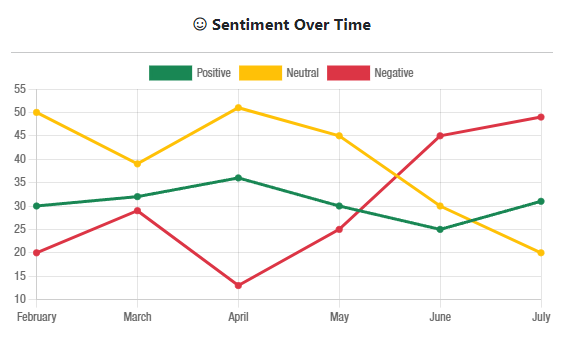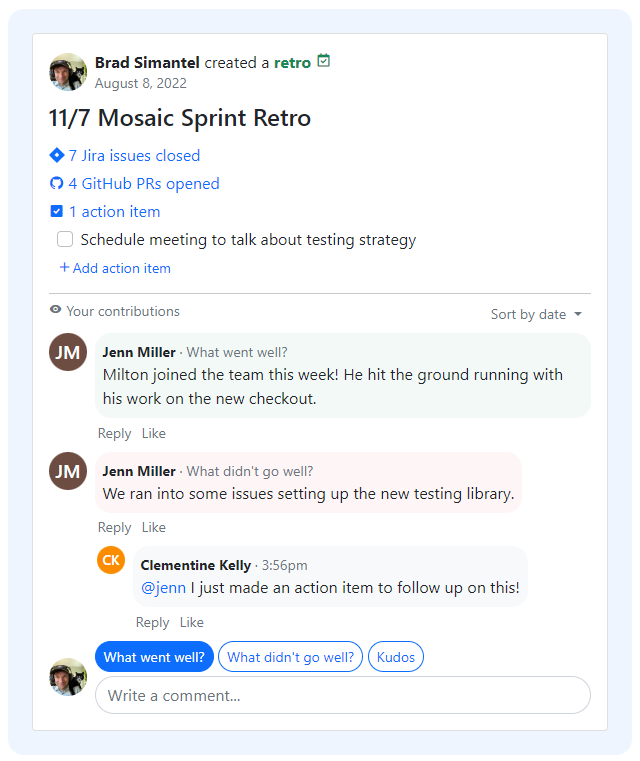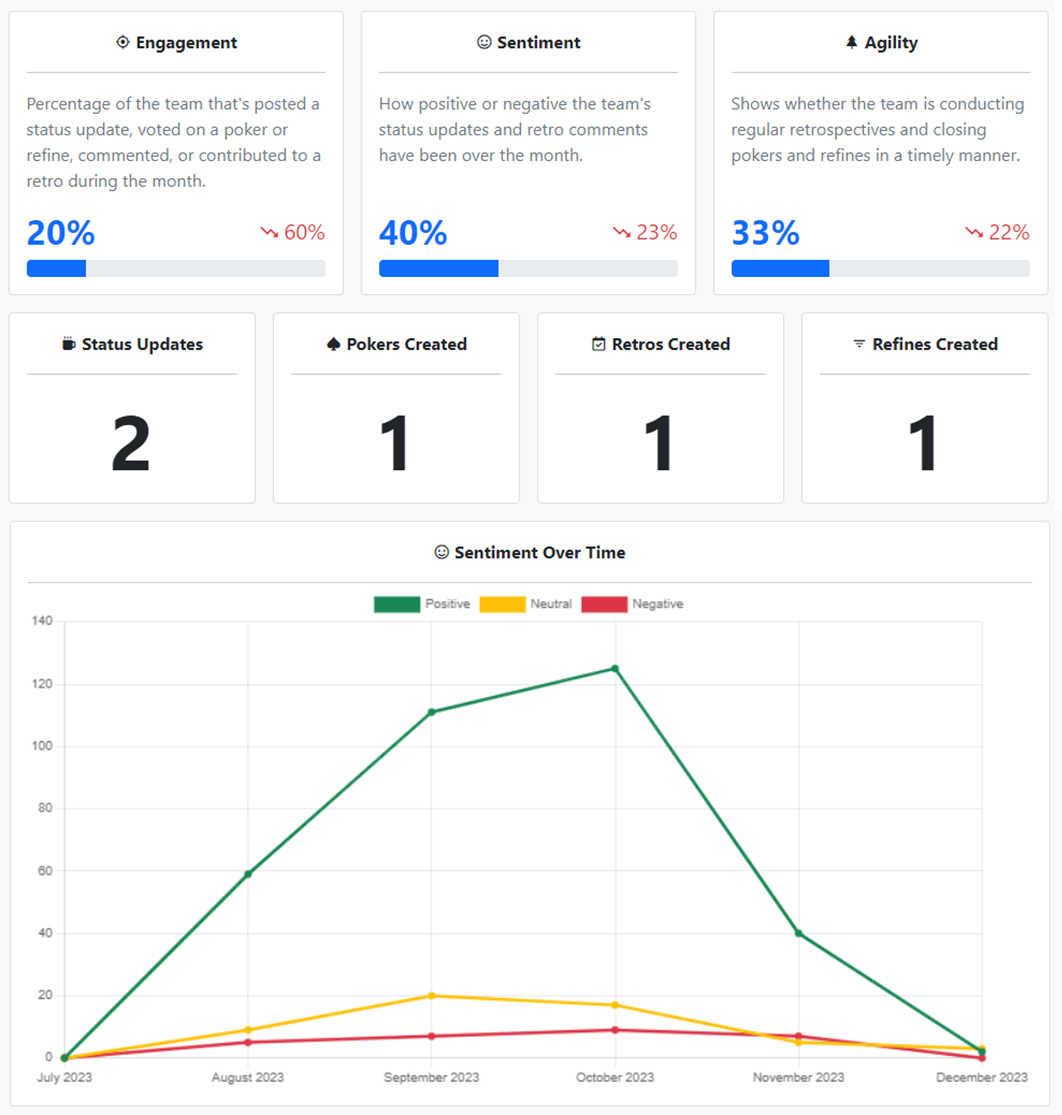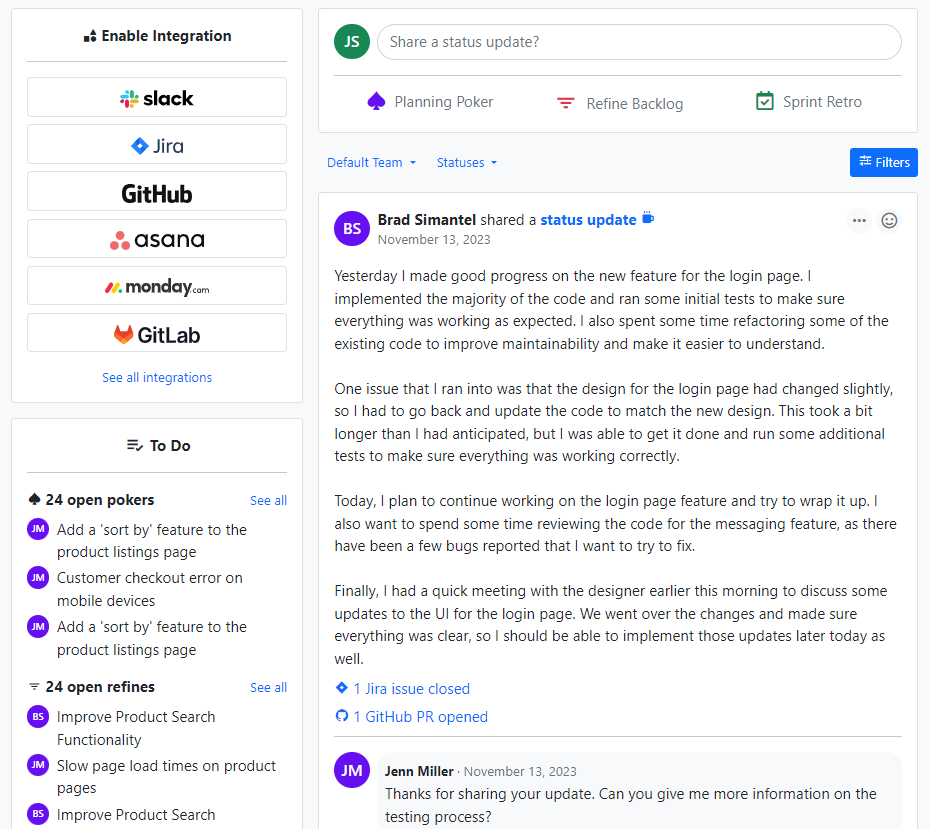Helpful summary
-
Overview: This article covers our platform (Teaminal) and how it optimizes Agile reporting and collaboration for high-velocity, distributed Agile teams.
-
Why Trust Our Advice: We’ve helped companies like Angi, Medium, and PIKWIK optimize their Agile reporting and Agile workflows—and we’re confident we can help you too.
-
Why It Matters: Effective Agile reporting supports decision-making, improves efficiency, and enhances customer value.
-
Action Points: Articulate your Agile reporting goals, select relevant metrics, use platforms like Teaminal that bring the power of Agile reporting to distributed teams through async tools.
-
Further Research: Take a look at our guide to optimizing your Agile workflow for an overview of our entire process.
Want to learn more about Agile reporting?
Agile reporting plays an important (but all too often overlooked) role in the success of Agile teams.
It provides valuable insights into team productivity, project progress, and customer satisfaction. By tracking key metrics and identifying areas for improvement, you can continuously refine your workflow and deliver better results.
In this Teaminal guide, we’ll be helping you do more with your data by introducing you to the power of Agile reporting and showing you how to use it effectively in your team. Whether you’re new to Agile or a seasoned pro, this guide will help you take your team’s performance to the next level.
Let’s get started.
Why listen to us?
Teaminal has helped companies like Hello Fresh, Workday, T-Mobile, and PIKWIK improve productivity and alignment through optimized Agile workflows.

Our platform is designed with distributed teams in mind, with async options for Agile rituals and a range of impactful reports and metrics to draw on. We know Agile inside and out, and we’re passionate about helping teams unlock their full potential.
What is Agile reporting?
Agile reporting is the process of transforming Agile data into useful, actionable insights. This data can come from various sources, including:
-
Retrospectives
-
Sprint planning meetings
-
Daily standups
-
Project management tools (Jira, Asana, etc.)
-
Code repositories (GitHub, Bitbucket, etc.)
Usually, an Agile reporting tool will collect and display this data in a visual format, such as charts or graphs. The goal is to provide teams with a clear understanding of their progress, bottlenecks, and overall performance.

To give an example, Teaminal draws data on team sentiment and engagement from our Agile meeting features. Our platform them transforms this data into a range of useful dashboards, reports, and charts that you can use to visualize trends, spot potential issues, and make data-driven decisions.

We also display important metrics (Jira issues closed, GitHub PRs opened, etc.) along with async retros to give your team a holistic view of their work and impact. This not only helps teams to track their progress, but also fosters a culture of transparency and accountability.
Why should you optimize your Agile reporting?
Better decision-making
The biggest benefit of optimizing your Agile reporting is the ability to make better decisions. With accurate and up-to-date metrics, you can quickly assess the status of your team’s work and identify any areas that may need attention.
This also has a tendency to trickle down to other benefits, like…
Improved efficiency
Tracking and analyzing data on capacity, velocity, and cycle time can help teams identify bottlenecks and inefficiencies in their processes. This allows for targeted improvements to increase productivity and streamline workflows.
Increased transparency
Finally, clear and comprehensive Agile reporting creates a culture of transparency within a team. When everyone has access to the same data, there is less room for miscommunication or misunderstandings. This also promotes accountability, as team members can see their progress and contributions.
How we optimized Agile reporting
1. Define your purpose and goals
The first step in this process is setting clear goals for your Agile reporting.
There are an essentially unlimited details you can track and measure—and tracking all of them in a way that leads to positive change is impossible. Goals let you set a clear focus and keep your entire team aligned.
So, what are you trying to achieve? Do you want to improve team sentiment? Do you want to reduce the number of bugs in your code? Do you want to increase productivity?

Once you know what you are trying to achieve, it becomes much easier to decide what metrics and data points to track (and how). For example, if improving team sentiment is one of your goals, you’ll need to poll your team at regular intervals to collect feedback data using a tool like Teaminal.
The goals you set should be SMART, too:
-
Specific (e.g., “Increase sales by 10%” instead of “Improve sales”)
-
Measurable (e.g., using metrics like revenue, customer retention rate, etc.)
-
Achievable (based on current resources and capabilities)
-
Relevant (aligned with overall business objectives)
-
Time-bound (with a specific timeframe for achieving the goal)
This ensures that your goals are actionable and realistic.
2. Choose relevant metrics
Next, it’s time to choose the metrics you’ll track.
These should be paired with goals via an input-output relationship—a change in a metric should map to progress towards a goal. For example, if your goal is to increase productivity, you may track metrics like:
-
Time spent on tasks
-
Number of completed tasks per day
-
Project completion rate
Select metrics that adhere to the SMART criteria—some metrics (vanity metrics) may look good on paper, but don’t actually measure progress towards your goals.
A great example of this is “number of account activations” which may seem like a positive metric, but it doesn’t necessarily mean those accounts are actively being used or generating revenue. If a metric doesn’t offer you actionable insights into progress, it’s probably best to swap it out for one that does.
3. Use the right tools
Agile reporting requires the use of specific tools that are designed to support the principles and practices of Agile project management. These tools are essential for effective communication, collaboration, and tracking progress in an Agile environment.
Teaminal is a great example.

We designed Teaminal to give distributed Agile teams a seamless, impactful way to conduct Agile rituals like planning poker, standups, retrospectives, and more without wasting valuable development time on lengthy meetings. Instead, we use quick async Slack sessions to win back hours each week.

A big part of this mission is making sure your data is packaged meaningfully through reports and dashboards. Project managers and team members can easily track engagement, sentiment, and agility, as well as how Teaminal’s features are being used.
Our platform also integrates with popular Agile project management tools like Jira, Trello, and Asana to allow you to pull in data from third-party sources.
4. Regularly update and review reports
The goal of Agile reporting is improvement—or change, in other words. And as your processes change, so should your reports. It’s important to regularly review and update your reports to make sure they reflect the most current data and accurately represent your team’s progress.
Say you find through reporting that synchronous daily standup meetings are cutting 50 hours of development time each month (average for a 10-person team), and switch to asynchronous updates instead. You’ll want to update your reports to reflect this change in process and measure its impact on development time.
5. Communicate effectively
Last, but not least—communication is key in Agile reporting.
The success of your reports hinges on how well you communicate the data and insights to stakeholders and team members. This includes choosing the right format for presenting the information, keeping the language clear and concise, and providing context for the numbers and metrics being presented.
As we mentioned in our Agile reporting tools guide, many tools are cognizant of the fact that not everyone reading Agile reports will be as familiar with the methodology as you are (think CEOs and investors). As such, they offer features for tailoring reports to the people reading them.
Additionally, you should also think about Agile communication in general—how you interact with your team on a regular basis. For example, at Teaminal, we’ve built our tool to be used within Slack to minimize switching costs and inefficiency.
Conclusion
Agile reporting is key to the long-term success and productivity of any Agile team. Without easy access to meaningful data, you’ll often find yourself relying on gut decisions and guesswork—not ideal for standardizing your processes and landing on a system that works for your team.
By optimizing your reporting process, you can make sure that everyone is on the same page and has access to the information they need to make informed decisions. This helps with all kinds of Agile practices—from sprint planning to retrospectives and everything in between.
At Teaminal, we understand the importance of efficient and effective reporting in Agile environments. That’s why we’ve designed our tool to seamlessly integrate into your team’s existing workflow and provide real-time data on progress, blockers, and more.
Sign up for free and see what Teaminal can do.




